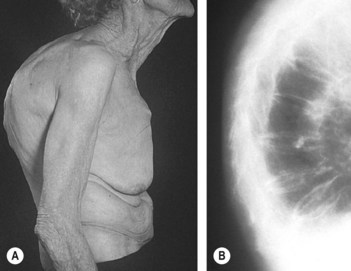247 Osteoporosis of the spine (dowager’s hump)
Salient features
History
• History of back pain (usually the onset is sudden with severe pain in the dorsal spine)
• Spontaneous fractures and loss of height
• Long-term corticosteroid, heparin therapy or proton pump inhibitors (>7 years of last) (CMAJ 2008;179:319–26)
• Postmenopausal or has had an oopherectomy
• Smoker or consumes alcohol (>3 units/day)
• Is there a family history particularly in a parent
• What is the patient’s weight (body mass index (BMI) <22 kg/m2 is associated with osteoporosis)
• Associated conditions: rheumatoid arthritis, uncontrolled diabetes mellitus, Crohn’s disease, ankylosing spondylitis, multiple myleoma, Cushing syndrome, thyrotoxicosis, oestrogen deficiency in women and androgen deficiency in men, Marfan syndrome, Ehlers–Danlos syndrome, homocystinura.
Advanced-level questions
What are the types of osteoporosis?
• Type I results from accelerated bone loss, particularly trabecular bone, and is probably caused by oestrogen deficiency. It typically results in fractures of vertebral bodies and the distal forearm in women in their 60s and 70s.
• Type II results from age-related bone loss and is much slower. It occurs in both sexes and typically results in fracture of the proximal femur in the elderly.
• Secondary osteoporosis: accounts for about 20% of cases in women and 40% of cases in men.
What are the typical sites of fracture in osteoporosis?
Vertebrae, neck of femur and distal radius (Colles’ fracture).
Stay updated, free articles. Join our Telegram channel

Full access? Get Clinical Tree



